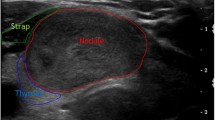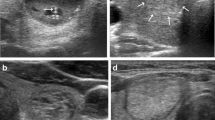Abstract
Objectives
To determine the contribution of a modified definition of markedly hypoechoic in the differential diagnosis of thyroid nodules.
Methods
A total of 1031 thyroid nodules were included in this retrospective multicenter study. All of the nodules were examined with US before surgery. The US features of the nodules were evaluated, in particular, the classical markedly hypoechoic and modified markedly hypoechoic (decreased or similar echogenicity relative to the adjacent strap muscles). The sensitivity, specificity, and AUC of classical/modified markedly hypoechoic and the corresponding ACR-TIRADS, EU-TIRADS, and C-TIRADS categories were calculated and compared. The inter- and intraobserver variability in the evaluation of the main US features of the nodules was assessed.
Results
There were 264 malignant nodules and 767 benign nodules. Compared with classical markedly hypoechoic as a diagnostic criterion for malignancy, using modified markedly hypoechoic as the criterion resulted in a significant increase in sensitivity (28.03% vs. 63.26%) and AUC (0.598 vs. 0.741), despite a significant decrease in specificity (91.53% vs. 84.88%) (p < 0.001 for all). Compared to the AUC of the C-TIRADS with the classical markedly hypoechoic, the AUC of the C-TIRADS with the modified markedly hypoechoic increased from 0.878 to 0.888 (p = 0.01); however, the AUCs of the ACR-TIRADS and EU-TIRADS did not change significantly (p > 0.05 for both). There was substantial interobserver agreement (κ = 0.624) and perfect intraobserver agreement (κ = 0.828) for the modified markedly hypoechoic.
Conclusion
The modified definition of markedly hypoechoic resulted in a significantly improved diagnostic efficacy in determining malignant thyroid nodules and may improve the diagnostic performance of the C-TIRADS.
Clinical relevance statement
Our study found that, compared with the original definition, modified markedly hypoechoic significantly improved the diagnostic performance in differentiating malignant from benign thyroid nodules and the predictive efficacy of the risk stratification systems.
Key Points
• Compared with the classical markedly hypoechoic as a diagnostic criterion for malignancy, the modified markedly hypoechoic resulted in a significant increase in sensitivity and AUC.
• The C-TIRADS with the modified markedly hypoechoic achieved higher AUC and specificity than that with the classical markedly hypoechoic (p = 0.01 and < 0.001, respectively).




Similar content being viewed by others
Abbreviations
- AUC:
-
Area under the ROC curve
- FNA:
-
Fine needle aspiration
- ROC:
-
Receiver operating characteristic
- TIRADS:
-
Thyroid Imaging Reporting and Data System
References
Durante C, Grani G, Lamartina L, Filetti S, Mandel SJ, Cooper DS (2018) The diagnosis and management of thyroid nodules: a review. JAMA 319:914–924
Haugen BR, Alexander EK, Bible KC et al (2016) 2015 American Thyroid Association management guidelines for adult patients with thyroid nodules and differentiated thyroid cancer: the American Thyroid Association Guidelines Task Force on Thyroid Nodules and Differentiated Thyroid Cancer. Thyroid 26:1–133
Trigo JM, Capdevila J, Grande E, Grau J, Lianes P, Spanish Society for Medical O (2014) Thyroid cancer: SEOM clinical guidelines. Clin Transl Oncol 16:1035-1042
Tessler FN, Middleton WD, Grant EG et al (2017) ACR thyroid imaging, reporting and data system (TI-RADS): white paper of the ACR TI-RADS Committee. J Am Coll Radiol 14:587–595
Ha EJ, Chung SR, Na DG et al (2021) 2021 Korean thyroid imaging reporting and data system and imaging-based management of thyroid nodules: Korean Society of Thyroid Radiology consensus statement and recommendations. Korean J Radiol 22:2094–2123
Russ G, Bonnema SJ, Erdogan MF, Durante C, Ngu R, Leenhardt L (2017) European thyroid association guidelines for ultrasound malignancy risk stratification of thyroid nodules in adults: the EU-TIRADS. Eur Thyroid J 6:225–237
Zhou J, Yin L, Wei X et al (2020) 2020 Chinese guidelines for ultrasound malignancy risk stratification of thyroid nodules: the C-TIRADS. Endocrine 70:256–279
Gharib H, Papini E, Garber JR et al (2016) American Association of Clinical Endocrinologists, American College of Endocrinology, and Associazione Medici Endocrinologi medical guidelines for clinical practice for the diagnosis and management of thyroid nodules–2016 update. Endocr Pract 22:622–639
Grant EG, Tessler FN, Hoang JK et al (2015) Thyroid ultrasound reporting lexicon: white paper of the ACR Thyroid Imaging, Reporting and Data System (TIRADS) Committee. J Am Coll Radiol 12:1272–1279
Moon WJ, Jung SL, Lee JH et al (2008) Benign and malignant thyroid nodules: US differentiation–multicenter retrospective study. Radiology 247:762–770
Remonti LR, Kramer CK, Leitao CB, Pinto LC, Gross JL (2015) Thyroid ultrasound features and risk of carcinoma: a systematic review and meta-analysis of observational studies. Thyroid 25:538–550
Kwak JY, Han KH, Yoon JH et al (2011) Thyroid imaging reporting and data system for US features of nodules: a step in establishing better stratification of cancer risk. Radiology 260:892–899
Kim EK, Park CS, Chung WY et al (2002) New sonographic criteria for recommending fine-needle aspiration biopsy of nonpalpable solid nodules of the thyroid. AJR Am J Roentgenol 178:687–691
Yuan WH, Chiou HJ, Chou YH et al (2006) Gray-scale and color Doppler ultrasonographic manifestations of papillary thyroid carcinoma: analysis of 51 cases. Clin Imaging 30:394–401
Li RQ, Yuan GH, Chen M et al (2016) Evaluation of diagnostic efficiency of ultrasound features on malignant thyroid nodules in Chinese patients. Chin Med J (Engl) 129:1784–1788
Ren J, Liu B, Zhang LL et al (2015) A taller-than-wide shape is a good predictor of papillary thyroid carcinoma in small solid nodules. J Ultrasound Med 34:19–26
American Institute of Ultrasound in M, American College of R, Society for Pediatric R, Society of Radiologists in U (2013) AIUM practice guideline for the performance of a thyroid and parathyroid ultrasound examination. J Ultrasound Med 32:1319-1329
DeLong ER, DeLong DM, Clarke-Pearson DL (1988) Comparing the areas under two or more correlated receiver operating characteristic curves: a nonparametric approach. Biometrics 44:837–845
Landis JR, Koch GG (1977) The measurement of observer agreement for categorical data. Biometrics 33:159–174
Trzebinska A, Dobruch-Sobczak K, Jakubowski W, Jedrzejowski M (2014) Standards of the Polish Ultrasound Society - update. Ultrasound examination of thyroid gland and ultrasound-guided thyroid biopsy. J Ultrason 14:49–60
Park JY, Lee HJ, Jang HW et al (2009) A proposal for a thyroid imaging reporting and data system for ultrasound features of thyroid carcinoma. Thyroid 19:1257–1264
Xu SY, Zhan WW, Wang WH (2015) Evaluation of thyroid nodules by a scoring and categorizing method based on sonographic features. J Ultrasound Med 34:2179–2185
Russ G (2016) Risk stratification of thyroid nodules on ultrasonography with the French TI-RADS: description and reflections. Ultrasonography 35:25–38
Lee JY, Na DG, Yoon SJ et al (2020) Ultrasound malignancy risk stratification of thyroid nodules based on the degree of hypoechogenicity and echotexture. Eur Radiol 30:1653–1663
Takashima S, Matsuzuka F, Nagareda T, Tomiyama N, Kozuka T (1992) Thyroid nodules associated with Hashimoto thyroiditis: assessment with US. Radiology 185:125–130
Acknowledgements
The authors would like to thank all the staff working in ultrasound department of eight hospitals in the research.
Funding
This research did not receive any specific grant from any funding agency.
Author information
Authors and Affiliations
Corresponding author
Ethics declarations
Guarantor
The scientific guarantor of this publication is JianQiao Zhou, MD.
Conflict of interest
The authors declare no competing interests.
Statistics and biometry
No complex statistical methods were necessary for this paper.
Informed consent
Written informed consent was obtained from all subjects (patients) in this study.
Ethical approval
Institutional Review Board approval was obtained.
Study subjects or cohorts overlap
There was no overlap with any themes from previously published works.
Methodology
• retrospective
• diagnostic or prognostic study
• multicenter study
Additional information
Publisher's note
Springer Nature remains neutral with regard to jurisdictional claims in published maps and institutional affiliations.
Rights and permissions
Springer Nature or its licensor (e.g. a society or other partner) holds exclusive rights to this article under a publishing agreement with the author(s) or other rightsholder(s); author self-archiving of the accepted manuscript version of this article is solely governed by the terms of such publishing agreement and applicable law.
About this article
Cite this article
Liu, J., Luo, T., Zhang, H. et al. Markedly hypoechoic: a new definition improves the diagnostic performance of thyroid ultrasound. Eur Radiol 33, 7857–7865 (2023). https://doi.org/10.1007/s00330-023-09828-1
Received:
Revised:
Accepted:
Published:
Issue Date:
DOI: https://doi.org/10.1007/s00330-023-09828-1




